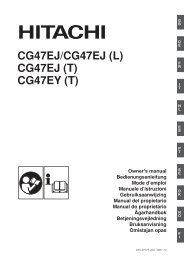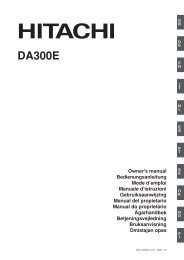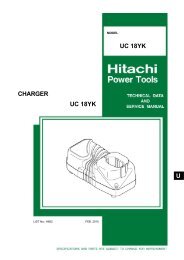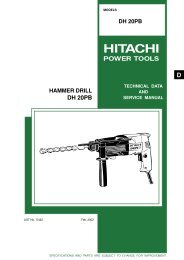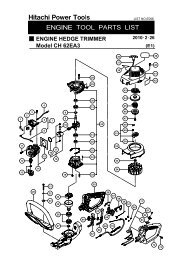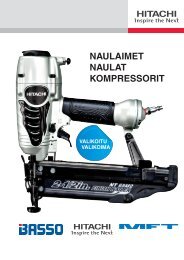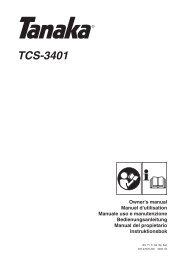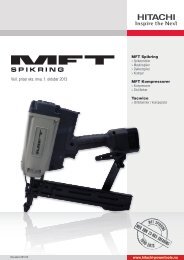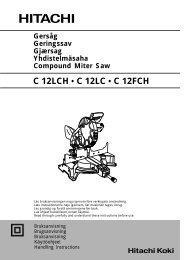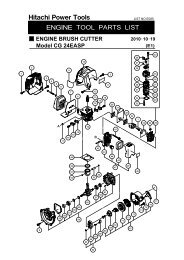CG40EK (LP) CG40EYA (TP) - Hitachi
CG40EK (LP) CG40EYA (TP) - Hitachi
CG40EK (LP) CG40EYA (TP) - Hitachi
You also want an ePaper? Increase the reach of your titles
YUMPU automatically turns print PDFs into web optimized ePapers that Google loves.
Fig. 3-1<br />
Fig. 3-2 Fig. 3-2B<br />
Fig. 3-3<br />
5. Maintenance<br />
MAINTENANCE, REPLACEMENT, OR REPAIR<br />
OF THE EMISSION CONTROL DEVICES AND<br />
SYSTEMS MAY BE PERFORMED BY ANY<br />
NON-ROAD ENGINE REPAIR<br />
ESTABLISHMENT OR INDIVIDUAL.<br />
Carburetor adjustment (Fig. 3-1)<br />
WARNING!<br />
The cutting attachment may be spinning<br />
during carburetor adjustments.<br />
WARNING!<br />
Never start the engine without the complete<br />
clutch cover and tube assembled! Otherwise<br />
the clutch can come loose and cause<br />
personal injuries.<br />
In the carburetor, fuel is mixed with air. When the<br />
engine is test run at the factory, the carburetor is<br />
basically adjusted. A further adjustment may be<br />
required, according to climate and altitude. The<br />
carburetor has one adjustment possibility:<br />
T = Idle speed adjustment screw.<br />
Idle speed adjustment (T)<br />
Check that the air filter is clean. When the idle<br />
speed is correct, the cutting attachment will not<br />
rotate. If adjustment is required, close (clockwise)<br />
the T-screw, with the engine running, until the<br />
cutting attachment starts to rotate. Open (counterclockwise)<br />
the screw until the cutting attachment<br />
stops. You have reached the correct idle speed<br />
when the engine runs smoothly in all positions<br />
well below the rpm when the cutting attachment<br />
starts to rotate.<br />
If the cutting attachment still rotates after idle<br />
speed adjustment, contact HITACHI dealer.<br />
NOTE!<br />
Standard Idle rpm is 2500~3000 rpm.<br />
WARNING!<br />
When the engine is idling the cutting<br />
attachment must under no circumstances<br />
rotate.<br />
NOTE!<br />
Some models sold areas with strict exhaust<br />
emission regulation do not have high and low<br />
speed carburetor adjustments. Such<br />
adjustments may allow the engine to be<br />
operated outside of their emission compliance<br />
limits. For these models, the only carburetor<br />
adjustment is idle speed.<br />
Air filter (Fig. 3-2)<br />
The air filter must be cleaned from dust and dirt<br />
in order to avoid:<br />
Carburetor malfunctions.<br />
Starting problems.<br />
Engine power reduction.<br />
Unnecessary wear on the engine parts.<br />
Abnormal fuel consumption.<br />
Clean the air filter daily or more often if working<br />
in exceptionally dusty areas.<br />
Cleaning the air filter<br />
Remove the air filter cover and the filter (1). Rinse<br />
it in warm soap suds. Check that the filter is dry<br />
before reassembly. An air filter that has been used<br />
for some time cannot be cleaned completely.<br />
Therefore, it must regularly be replaced with a new<br />
one. A damaged filter must always be replaced.<br />
Fuel filter (Fig. 3-2B)<br />
Drain all fuel from fuel tank and pull fuel filter line<br />
from tank. Pull filter element out of holder<br />
assembly and rinse element in warm water with<br />
detergent.<br />
Rinse thoroughly until all traces of detergent are<br />
eliminated. Squeeze, do not wring, away<br />
excess water and allow element to air dry.<br />
NOTE!<br />
If element is hard due to excessive dirt buildup,<br />
replace it.<br />
Spark plug (Fig. 3-3)<br />
The spark plug condition is influenced by:<br />
An incorrect carburetor setting.<br />
Wrong fuel mixture (too much oil in the gasoline)<br />
A dirty air filter.<br />
Hard running conditions (such as cold weather).<br />
These factors cause deposits on the spark plug<br />
electrodes, which may result in malfunction and<br />
starting difficulties. If the engine is low on power,<br />
difficult to start or runs poorly at idling speed,<br />
always check the spark plug first. If the spark<br />
plug is dirty, clean it and check the electrode gap.<br />
Re-adjust if necessary. The correct gap is 0.6<br />
mm. The spark plug should be replaced after<br />
about 100 operation hours or earlier if the<br />
electrodes are badly eroded.<br />
NOTE!<br />
In some areas, local law requires using a<br />
resistor spark plug to suppress ignition signals.<br />
If this machine was originally equipped with<br />
resistor spark plug, use same type of spark plug<br />
for replacement.<br />
GB-13



